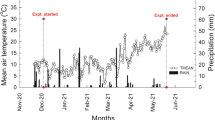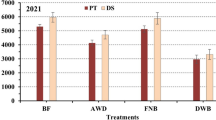Abstract
The article presents research on improving the elements of agricultural technology for the production of oilseed flax seeds and the selection of highly productive varieties of culture for the region. The experiments were conducted under the conditions of Ryazan oblast, on gray forest soil, in 2016–2019. It was established that oil flax sown on the first term of sowing in the first 10 days of May showed high productivity under the conditions of the southern part of the Non-Chernozem Earth Zone of Russia. This pattern was observed in all studied varieties of culture. The highest productivity was noted in 2016 for all studied flax varieties; maximum yield can be traced for the Istok variety in sowing time I (26.3 с/ ha). The maximum average yield for the Istok variety, according to the years of research, was 22.1 с/ha in sowing time I and 9.6 с/ha in sowing time II. Higher oil content was noted in the seeds obtained during sowing in the first 10 days of May for the VNIIMK-620, Istok, and Santin varieties and for the LM-98 variety sowing during the second 10 days of May. In the experiment, the Istok variety was late ripening, the average vegetation period was 126 days (sowing time I) and 118–119 days (sowing time II), while this index was 115 and 111 days, respectively, for the VNIIMK-620 variety.
Similar content being viewed by others
REFERENCES
Aspandiyarova, G.B., Cultivation of oil flax as an innovative project for diversification of agricultural crops, Pedagog. Nauka Prakt., 2018, no. 1, pp. 86–90.
Zakharova, O.A., Vinogradov, D.V., Byshov, N.V., et al., Results of monitoring studies of dried peat soils, Int. J. Adv. Biotechnol. Res., 2019, vol. 10, no. 2, pp. 474–489.
Vinogradov, D.V., Lupova, E.I., Byshov, N.V., et al., Production of oil flax seed in Non-Black Earth Zone of Russia, Int. J. Adv. Biotechnol. Res., 2019, vol. 10, no. 2, pp. 406–416.
Masterov, A.S., Vinogradov, D.V., et al., Praktikum po zemledeliyu (Manual on Agriculture), Ryazan: IP Zhukov, 2018.
Alford, D.V., Bio-Control of Oilseed Rape Insect Pests, Oxford: Blackwell Science, 2003, 116.
Bonell, M.L. and Lassaga, S.L., Genetic analysis of the response of linseed (Linum usitatissimum L.) somatic tissue to in vitro cultivation, Euphytica, 2002, vol. 125, no. 3, pp. 367–372.
Chirkov, V., Bakirova, G., Batasheva, S., et al., The influence of ammoniats on plant photosynthesis and productivity, Biol. Plant., 2006, vol. 44, no. 3, pp. 749–751.
Vakula, S., Ecological variability of oil and protein content in flaxseed, Vagos. Lzumokslodarbai, 2009, vol. 82, no. 35, pp. 77–81.
Vinogradov, D.V., Byshov, N.V., Evtishina, E.V., et al., Peculiarities of growing gold-of-pleasure for oilseeds and its use in feed production in the non-chernozem zone of Russia, Amazonia Investiga, 2018, vol. 7, no. 16, pp. 37–45.
Nosevich, M.A. and Aiissotode, I.Z., Seed productivity of different varieties of oil flax depending on the feeding area, Izv. S.-Peterb. Gos. Agrar. Univ., 2016, no. 45, pp. 40–44.
Polyakov, A.V., Biotekhnologiya v selektsii l’na: Monografiya (Biotechnology in Flax Breeding: Monograph), Tver: Familiya, 2000.
Prakhova, T.Ya., Prakhov, V.A., and Turina, E.A., Agroecological aspects of the formation of agrocenoses of non-traditional oilseeds, Izv. Samar. Nauchn. Tsentra Ross. Akad. Nauk, 2018, no. 2, pp. 357–362.
Kvavadze, E., 30,000-year-old wild flax fibers, Science, 2009, vol. 325, no. 5946, p. 1359.
Nichterlein, K., Umbach, H., and Friedt, W., Investigation on androgenesis in breeding of linseed (Linum usitatissimum L.), Vortr. Pflanzenzuecht., 1989, vol. 15, no. 1, pp. 13–25.
Ilieva, A. and Vasileva, V., Effect of liquid organic humate fertilizer Humustim on chemical composition of spring forage pea, Banat’s J. Biotechnol., 2013, vol. 4, no. 7, pp. 74–79.
Vasileva, V., Aboveground to root biomass ratios in pea and vetch after treatment with organic fertilizer, Global J. Environ. Sci. Manage., 2015, vol. 1, no. 2, pp. 71–74.
Metodika provedeniya polevykh i agrotekhnicheskikh opytov s maslichnymi kul’turami (Methodology for Field and Agrotechnical Experiments with Oilseeds), Lukomets, V.M., Ed., Krasnodar: VNIIMK, 2007.
Metodicheskie ukazaniya po opredeleniyu biokhimicheskikh pokazatelei kachestva masla i semyan maslichnykh kul’tur (Guidelines for the Determination of Biochemical Indicators of the Quality of Oil and Oilseeds), Krasnodar: VASKhNIL, 1986.
Dospekhov, B.A., Metodika polevogo opyta s osnovami statisticheskoi obrabotki rezul’tatov issledovanii (Field Experiment Techniques with Basics of Statistical Processing of Research Results), Moscow: Agroproizdat, 1985, 5th ed.
Author information
Authors and Affiliations
Corresponding authors
Ethics declarations
The authors declare that they have no conflict of interest. This article does not contain any studies involving animals or human participants performed by any of the authors.
Additional information
Translated by V. Mittova
About this article
Cite this article
Vinogradov, D.V., Mazhaysky, Y.A., Novikova, A.V. et al. Productivity of Oil Flax Varieties Depending on the Sowing Time in Russia’s Non-Chernozem-Zone. Russ. Agricult. Sci. 47, 118–122 (2021). https://doi.org/10.3103/S1068367421020178
Received:
Revised:
Accepted:
Published:
Issue Date:
DOI: https://doi.org/10.3103/S1068367421020178




